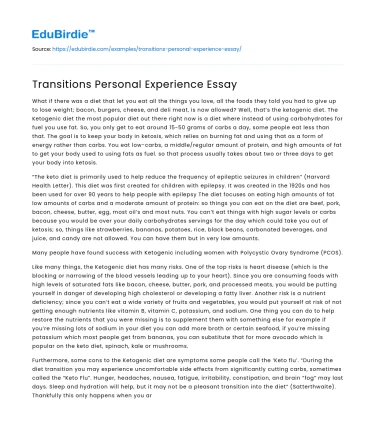What if there was a diet that let you eat all the things you love, all the foods they told you had to give up to lose weight; bacon, burgers, cheese, and deli meat, is now allowed? Well, that’s the ketogenic diet. The Ketogenic diet the most popular diet out there right now is a diet where instead of using carbohydrates for fuel you use fat. So, you only get to eat around 15-50 grams of carbs a day, some people eat less than that. The goal is to keep your body in ketosis, which relies on burning fat and using that as a form of energy rather than carbs. You eat low-carbs, a middle/regular amount of protein, and high amounts of fat to get your body used to using fats as fuel. so that process usually takes about two or three days to get your body into ketosis.
“The keto diet is primarily used to help reduce the frequency of epileptic seizures in children” (Harvard Health Letter). This diet was first created for children with epilepsy. It was created in the 1920s and has been used for over 90 years to help people with epilepsy The diet focuses on eating high amounts of fat low amounts of carbs and a moderate amount of protein: so things you can eat on the diet are beef, pork, bacon, cheese, butter, egg, most oil’s and most nuts. You can’t eat things with high sugar levels or carbs because you would be over your daily carbohydrates servings for the day which could take you out of ketosis; so, things like strawberries, bananas, potatoes, rice, black beans, carbonated beverages, and juice, and candy are not allowed. You can have them but in very low amounts.
Save your time!
We can take care of your essay
- Proper editing and formatting
- Free revision, title page, and bibliography
- Flexible prices and money-back guarantee
Many people have found success with Ketogenic including women with Polycystic Ovary Syndrome (PCOS).
Like many things, the Ketogenic diet has many risks. One of the top risks is heart disease (which is the blocking or narrowing of the blood vessels leading up to your heart). Since you are consuming foods with high levels of saturated fats like bacon, cheese, butter, pork, and processed meats, you would be putting yourself in danger of developing high cholesterol or developing a fatty liver. Another risk is a nutrient deficiency; since you can’t eat a wide variety of fruits and vegetables, you would put yourself at risk of not getting enough nutrients like vitamin B, vitamin C, potassium, and sodium. One thing you can do to help restore the nutrients that you were missing is to supplement them with something else for example if you’re missing lots of sodium in your diet you can add more broth or certain seafood, if you’re missing potassium which most people get from bananas, you can substitute that for more avocado which is popular on the keto diet, spinach, kale or mushrooms.
Furthermore, some cons to the Ketogenic diet are symptoms some people call the ‘Keto flu’. “During the diet transition you may experience uncomfortable side effects from significantly cutting carbs, sometimes called the “Keto Flu”. Hunger, headaches, nausea, fatigue, irritability, constipation, and brain “fog” may last days. Sleep and hydration will help, but it may not be a pleasant transition into the diet” (Satterthwaite). Thankfully this only happens when you are first transitioning into Keto and these symptoms should go away after about the first week or two after starting Keto.
Another con would be that it’s hard to stick to Keto for some people since you are cutting out lots of carbs from your diet, foods that you were typically told were good for you are now not allowed, because they would push you out of ketosis. For example, some people don’t like the idea that they can’t have lots of fruit like bananas because one banana has about 20 g of carbs, and if your daily carb intake is 25 grams, you’ve used up all of your carbs for the day. So most recommend that you stay away from fruit unless it’s in very small quantities. My personal experience would be to only eat fruit at the end of the day when I know I have a bit of wiggle room to eat more carbs instead of at the beginning of the day when I could use up all my carb intake for the day. Another reason keto is hard to stick with for most people is that they feel like they can’t go out to eat in restaurants, but in my personal experience, I’ve just learned to plan what I’m going to eat at restaurants ahead of time. So for example; if I’m going to Red robins for lunch, I would look at the menu before I get there and figure out how many carbs are in one dish and what I could substitute. So, if I was getting a burger I would get it bun-less and with no condiments like ketchup or mayo, and instead of fries, I would get something like broccoli or a side salad with no dressing because most dressings have high amounts of sugar. That’s usually how I eat out.






 Stuck on your essay?
Stuck on your essay?

